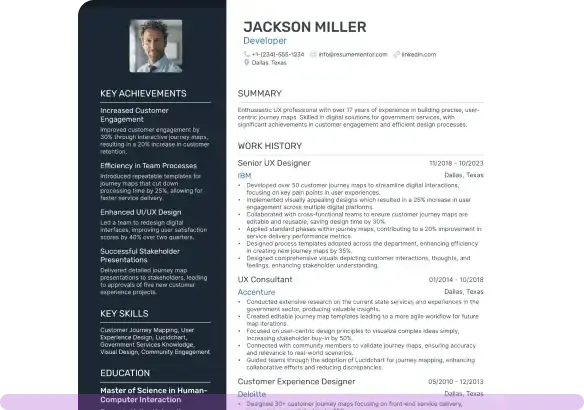User Interface Developer Resume Examples

Mar 24, 2025
|
12 min read
Craft a user interface developer resume that speaks volumes and designs your career path. Learn to highlight skills and experience uniquely, making your resume as interactive as the interfaces you create.
Rated by 348 people
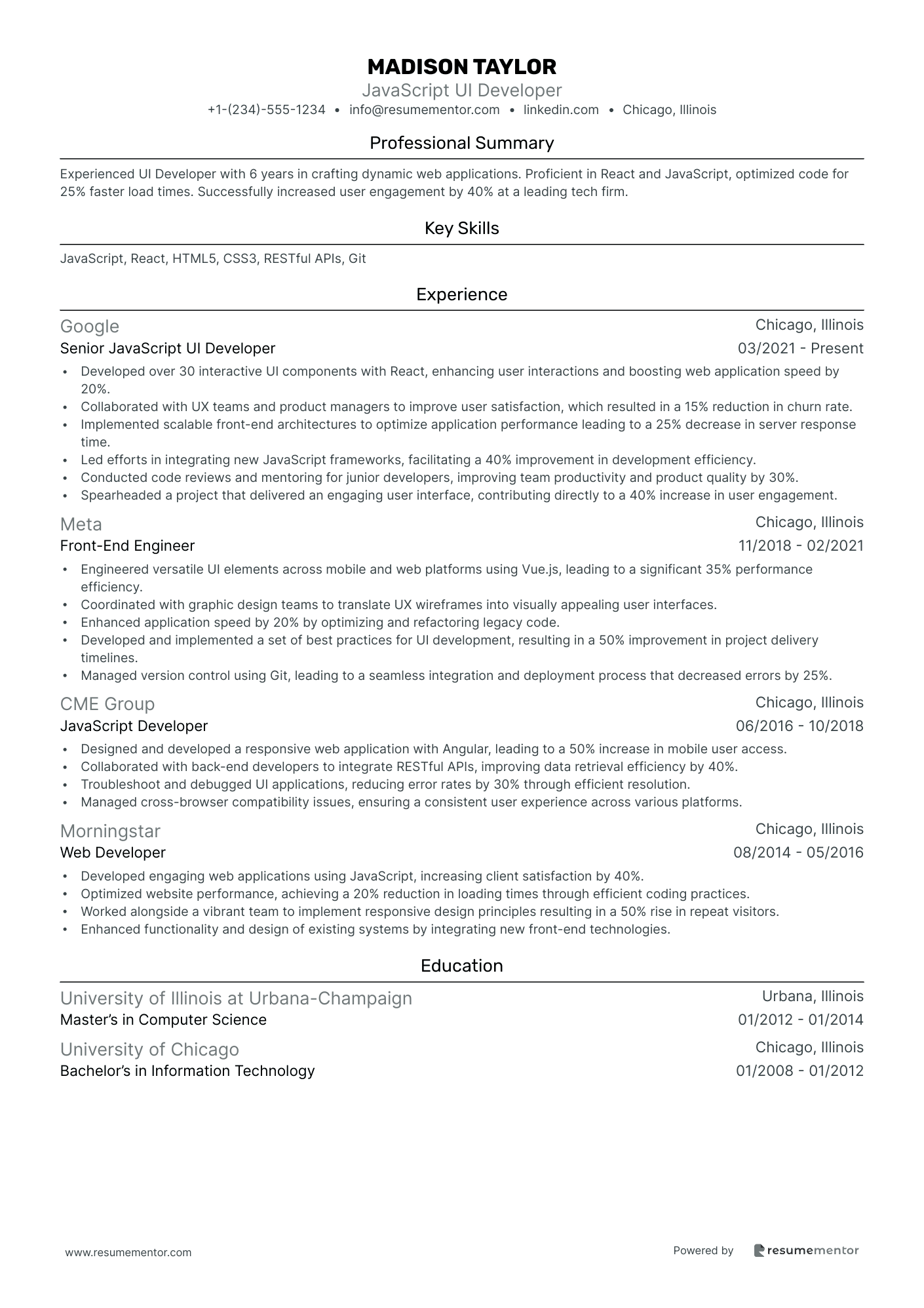
JavaScript UI Developer
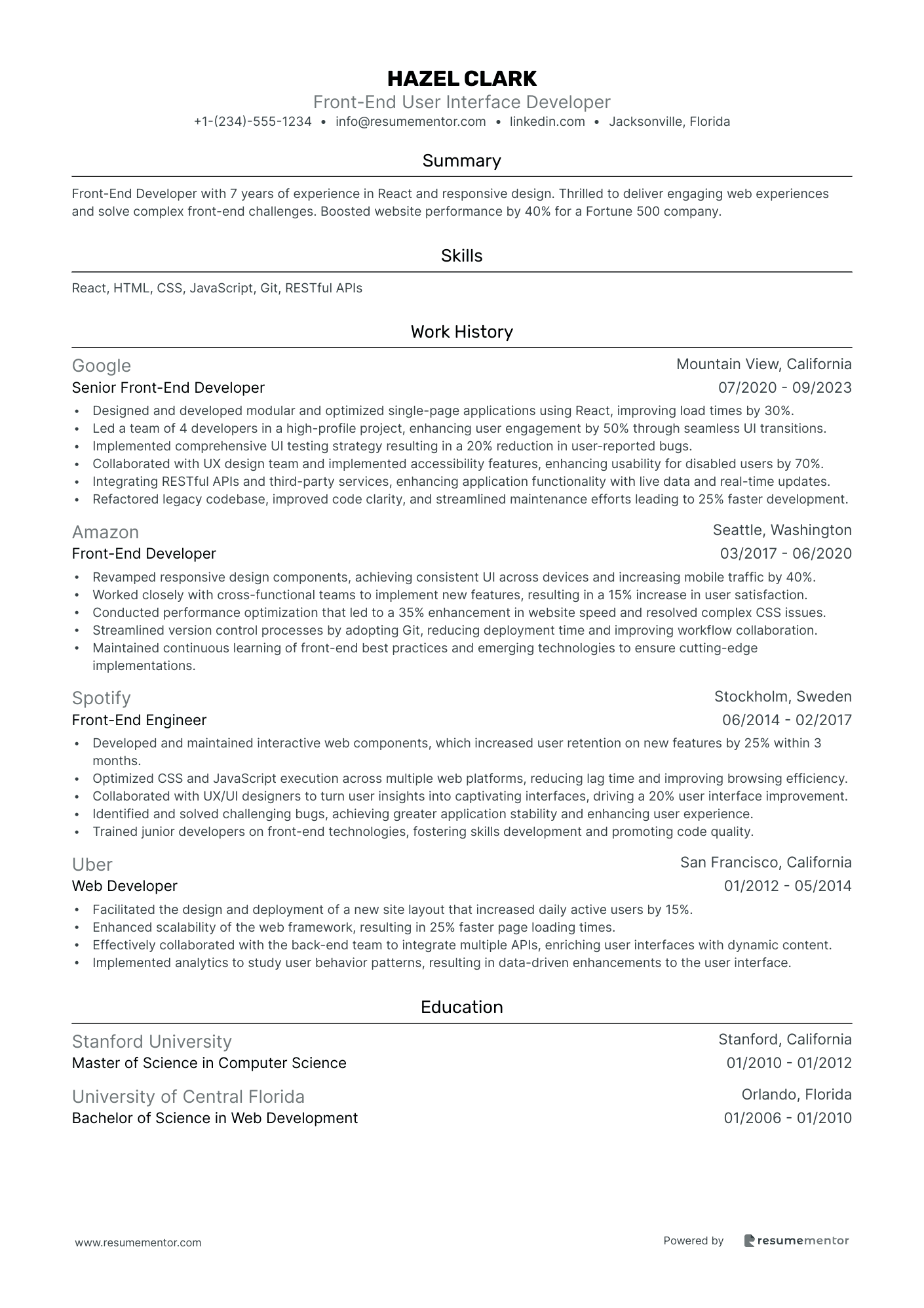
Front-End User Interface Developer
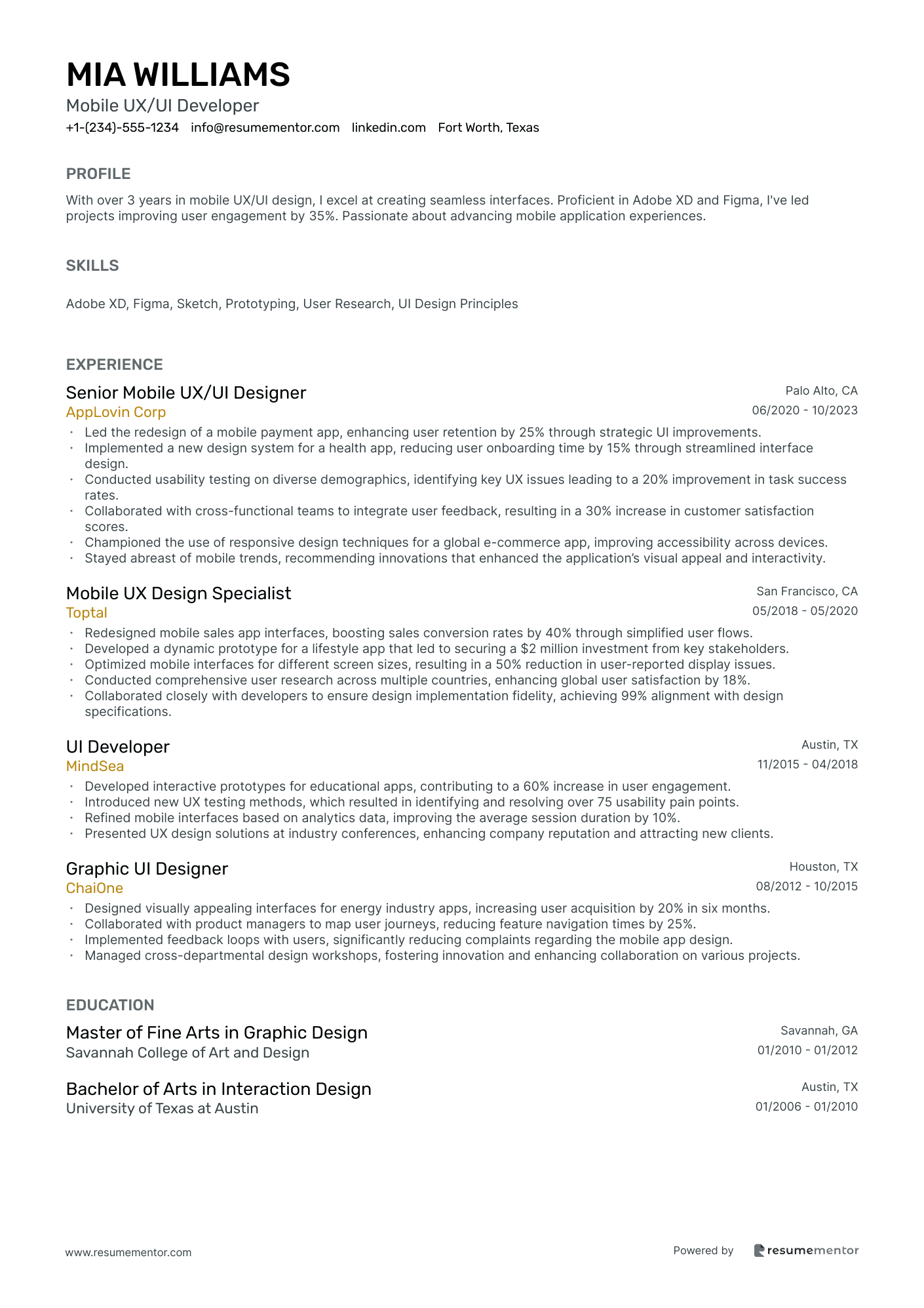
Mobile UX/UI Developer
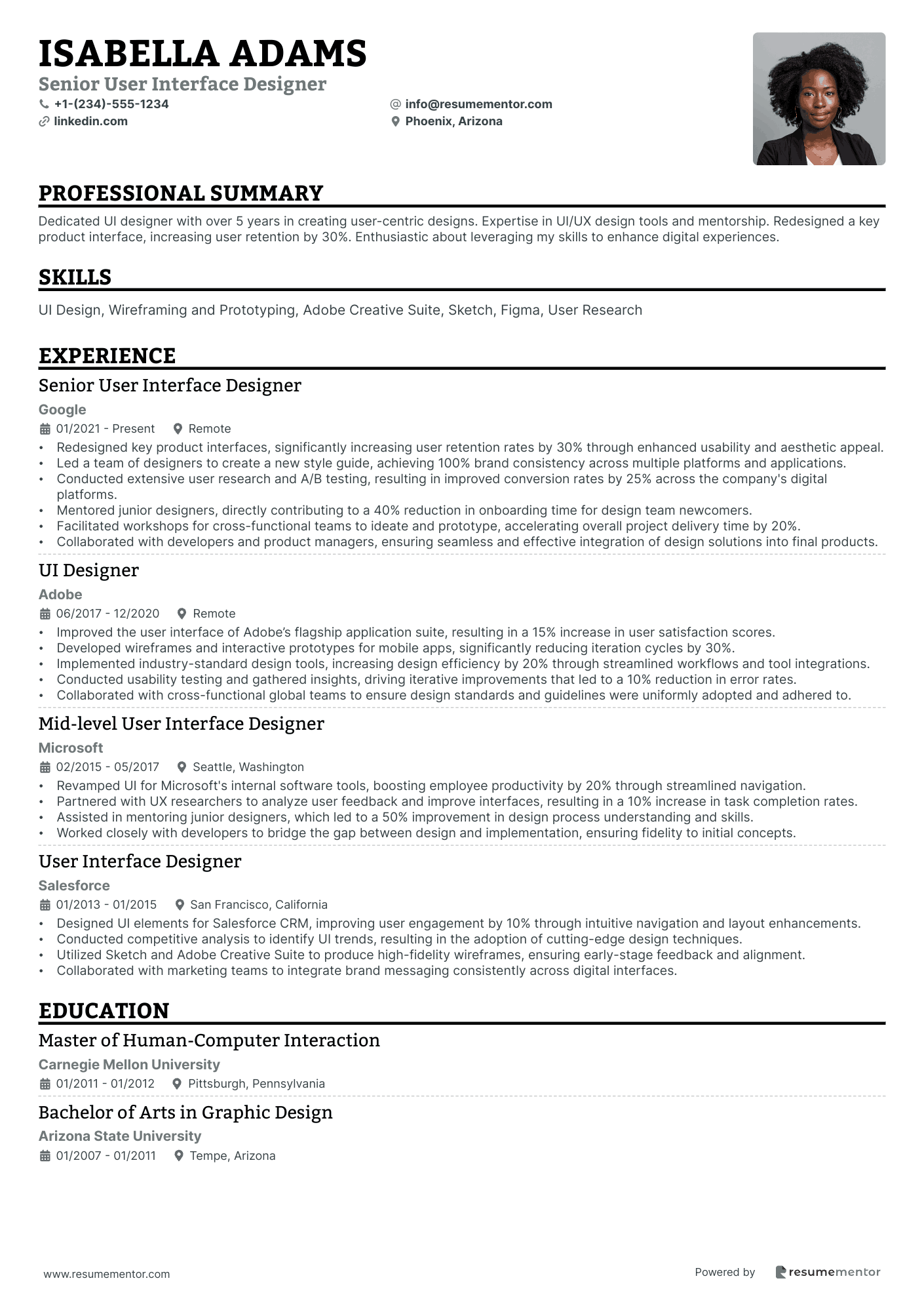
Senior User Interface Designer
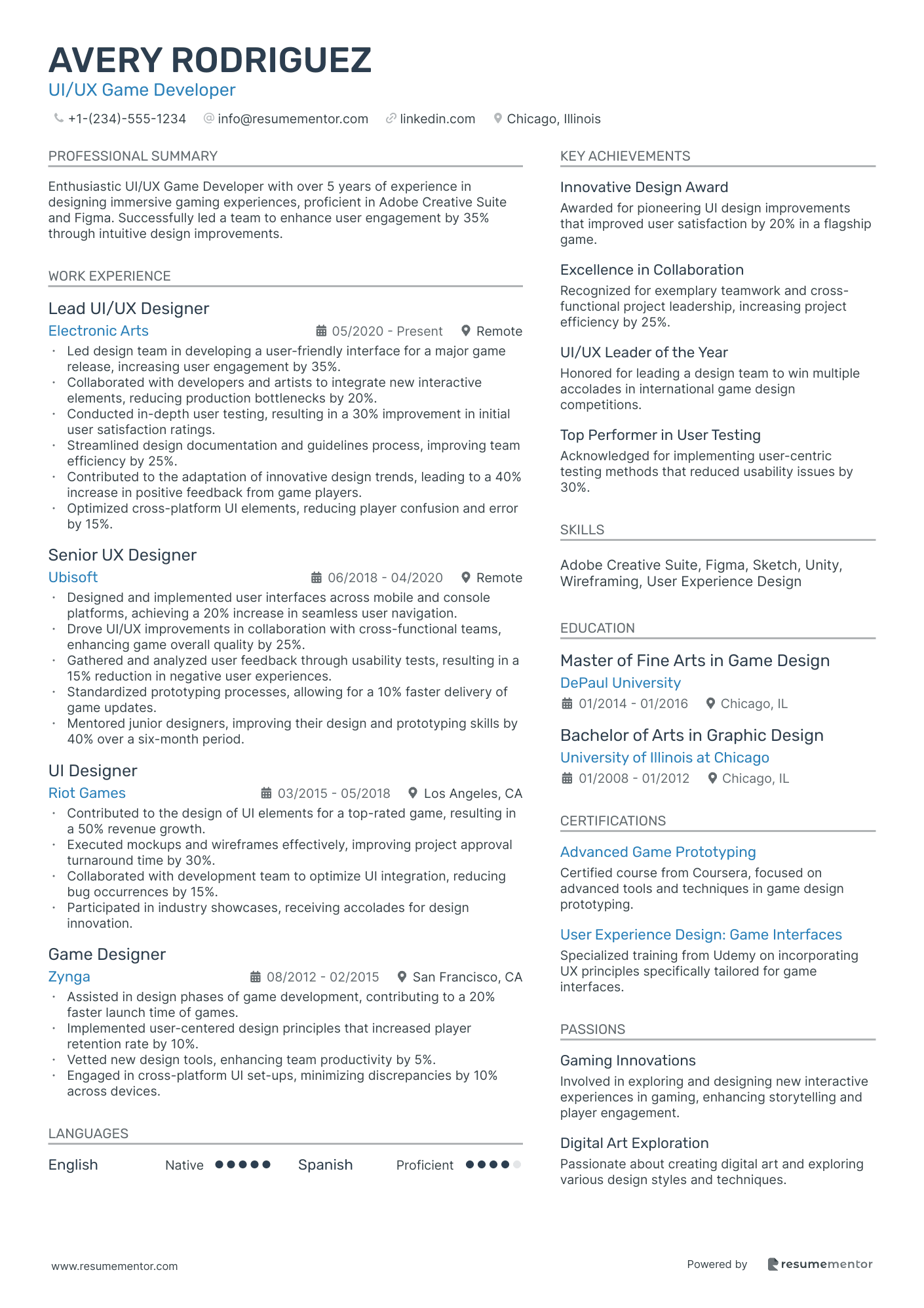
UI/UX Game Developer
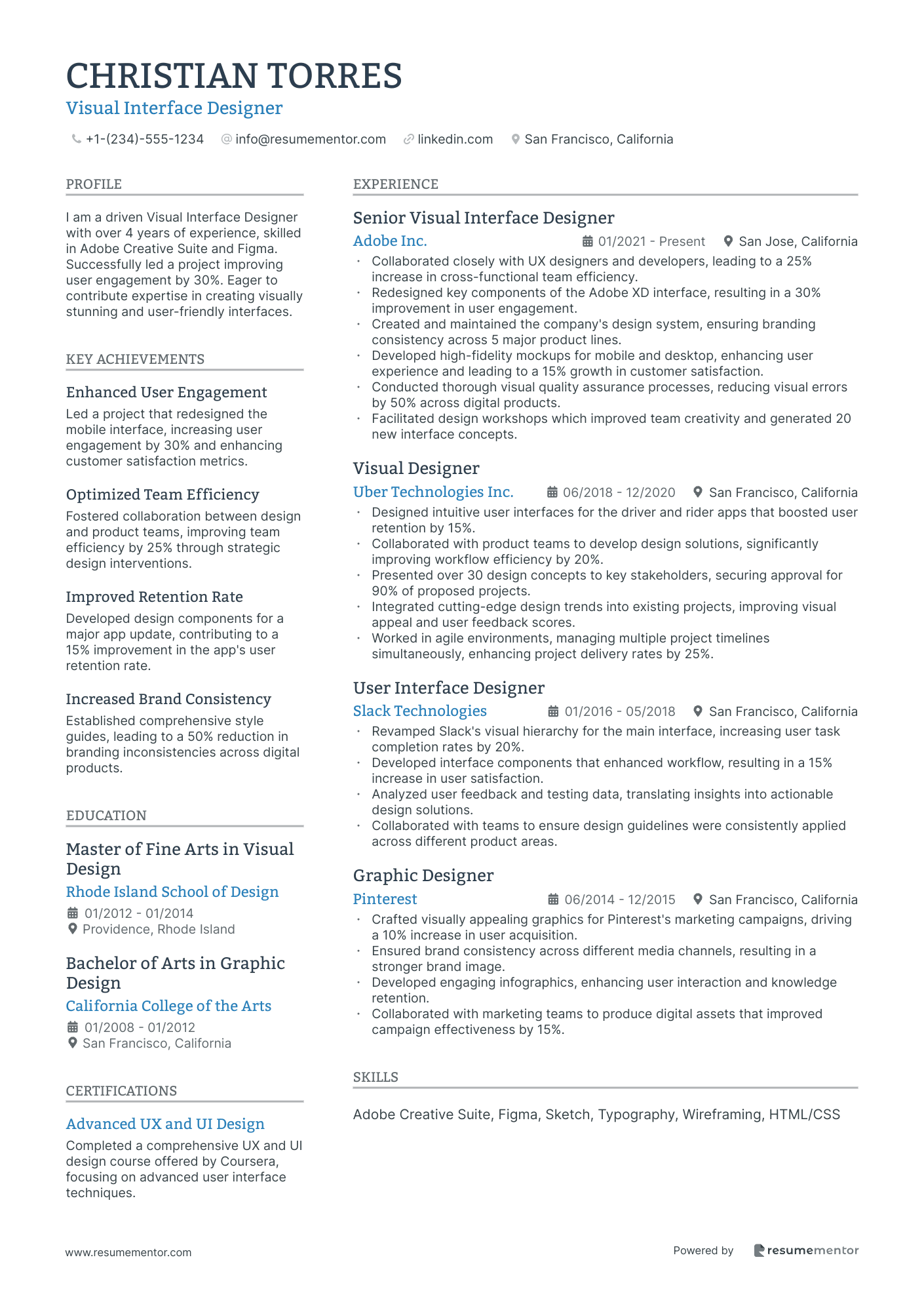
Visual Interface Designer
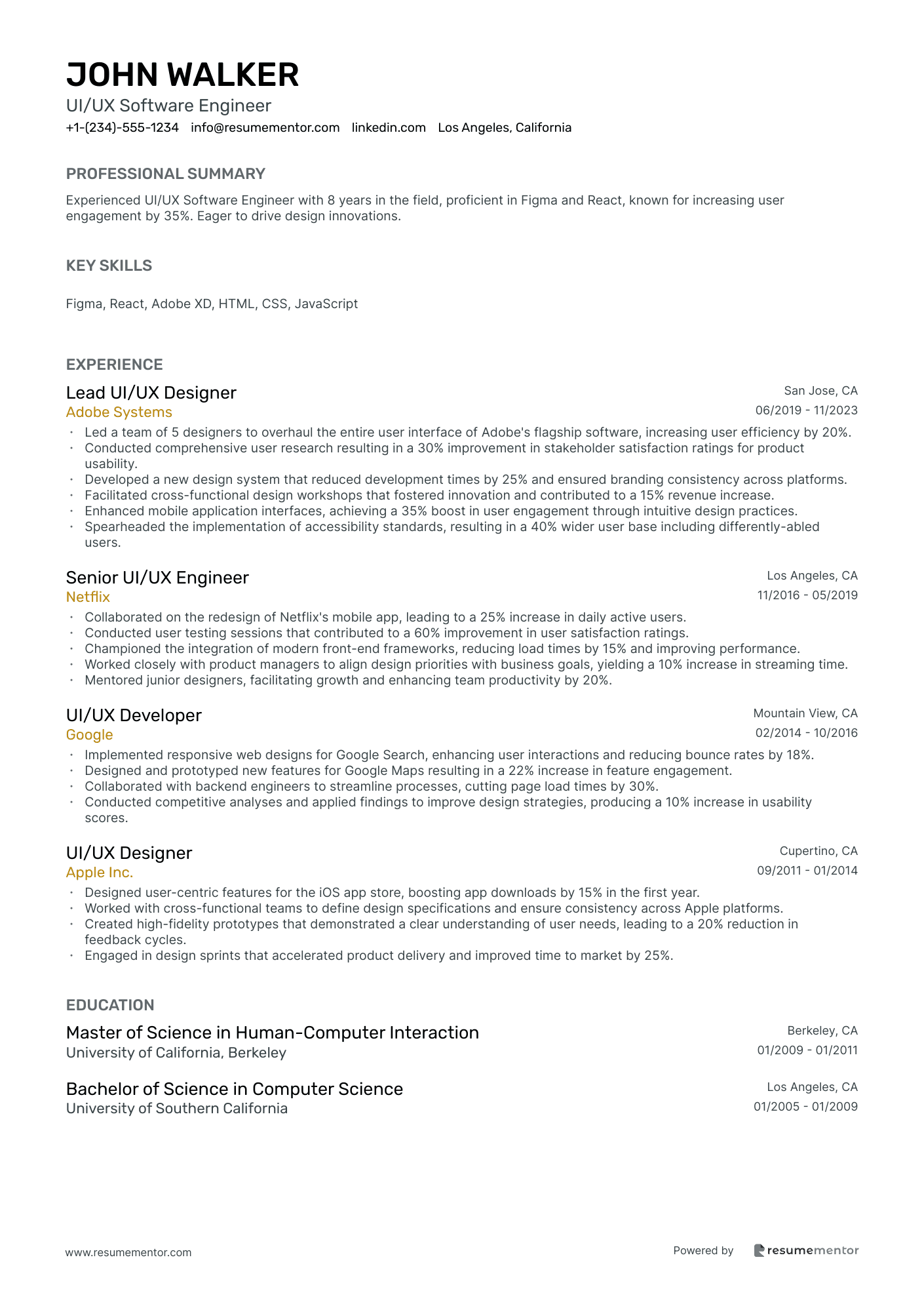
UI/UX Software Engineer
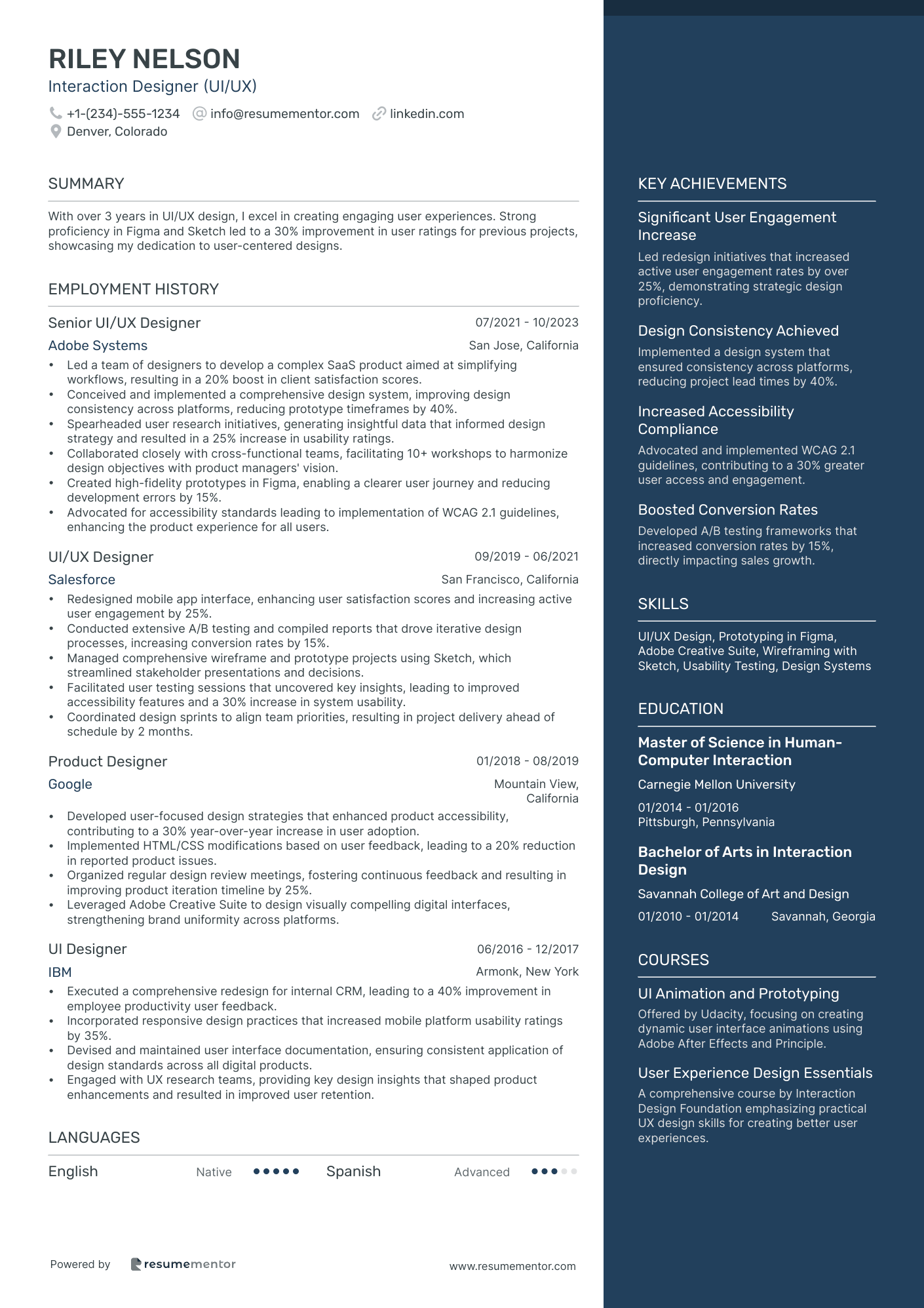
Interaction Designer (UI/UX)
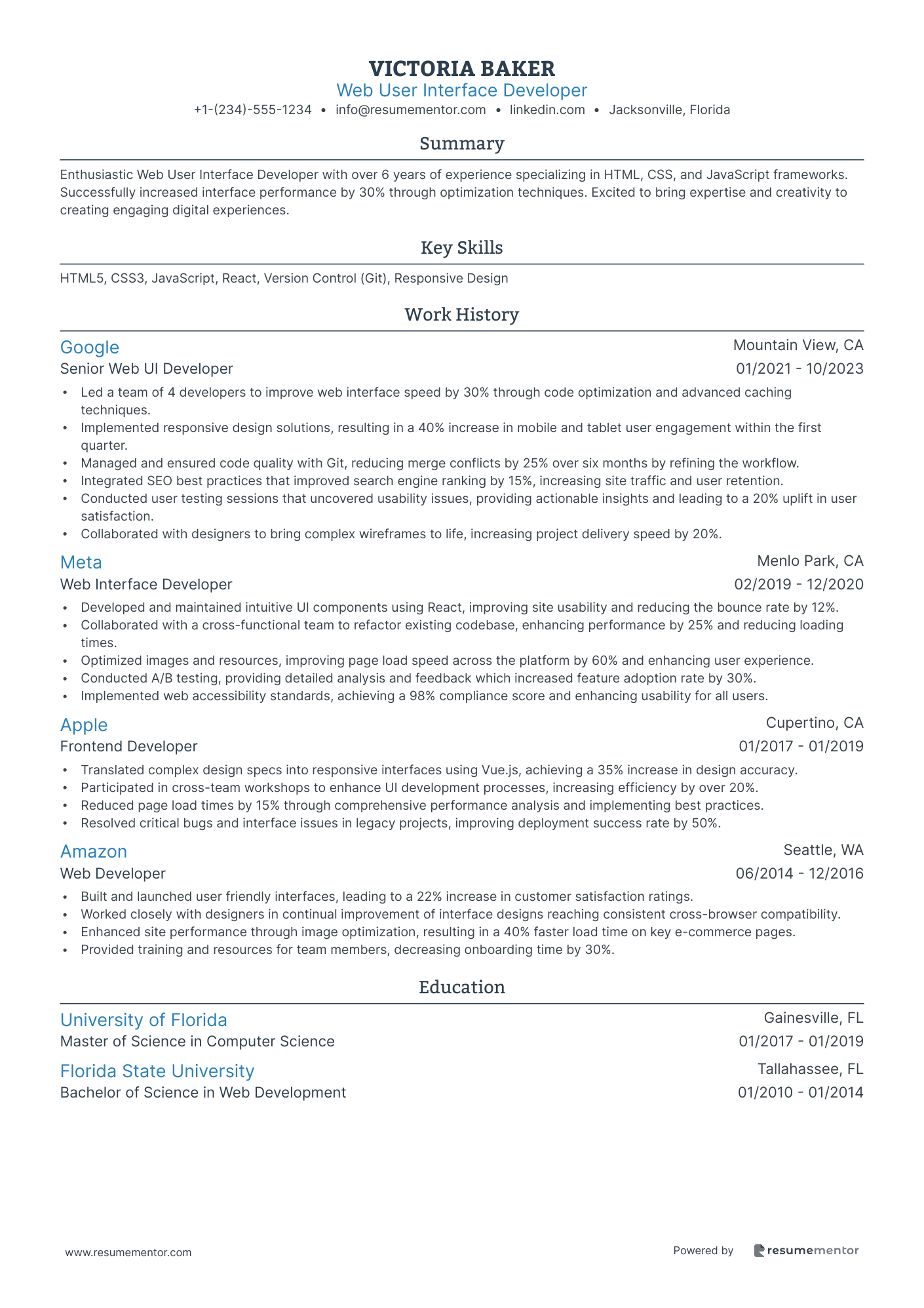
Web User Interface Developer
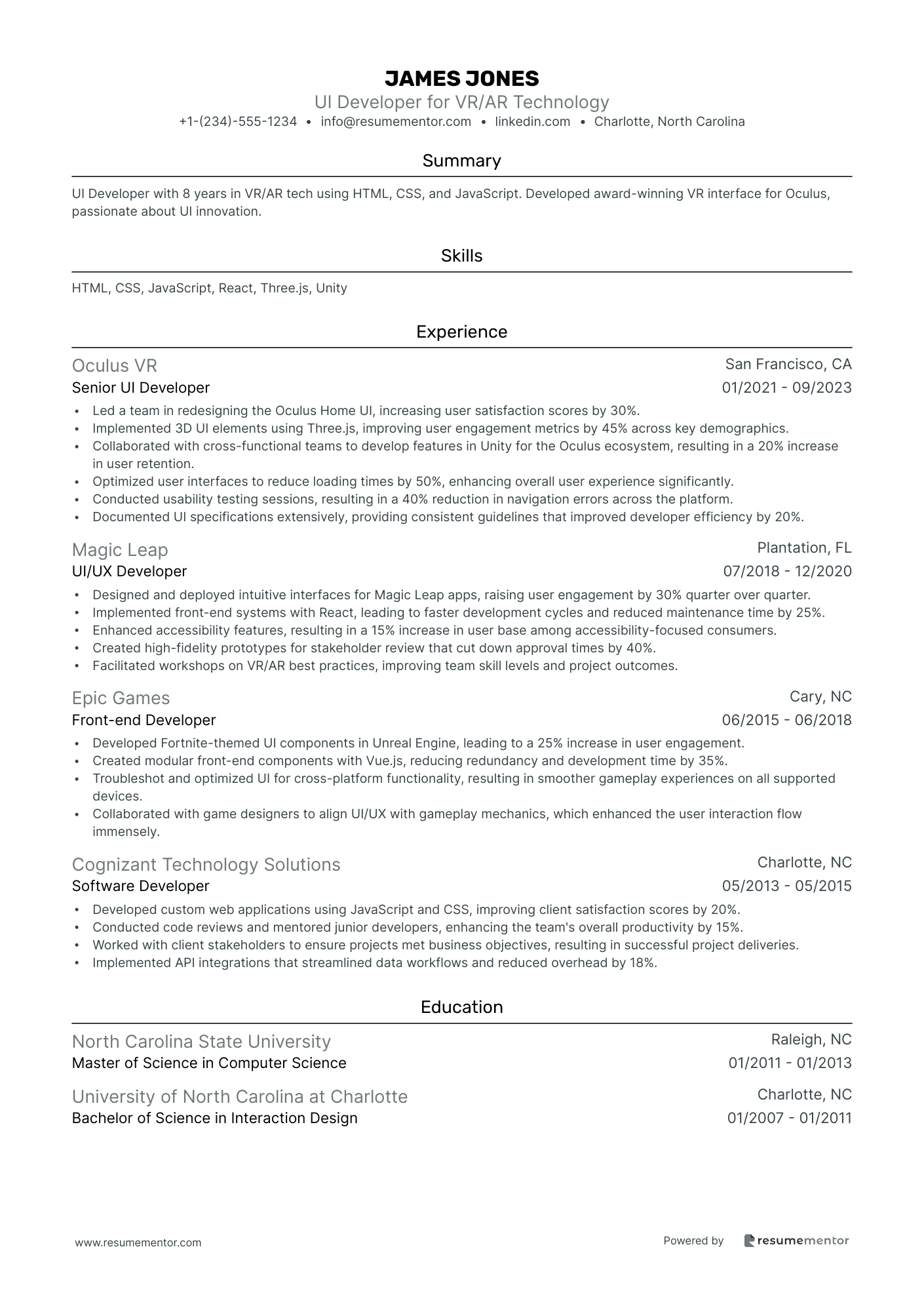
UI Developer for VR/AR Technology
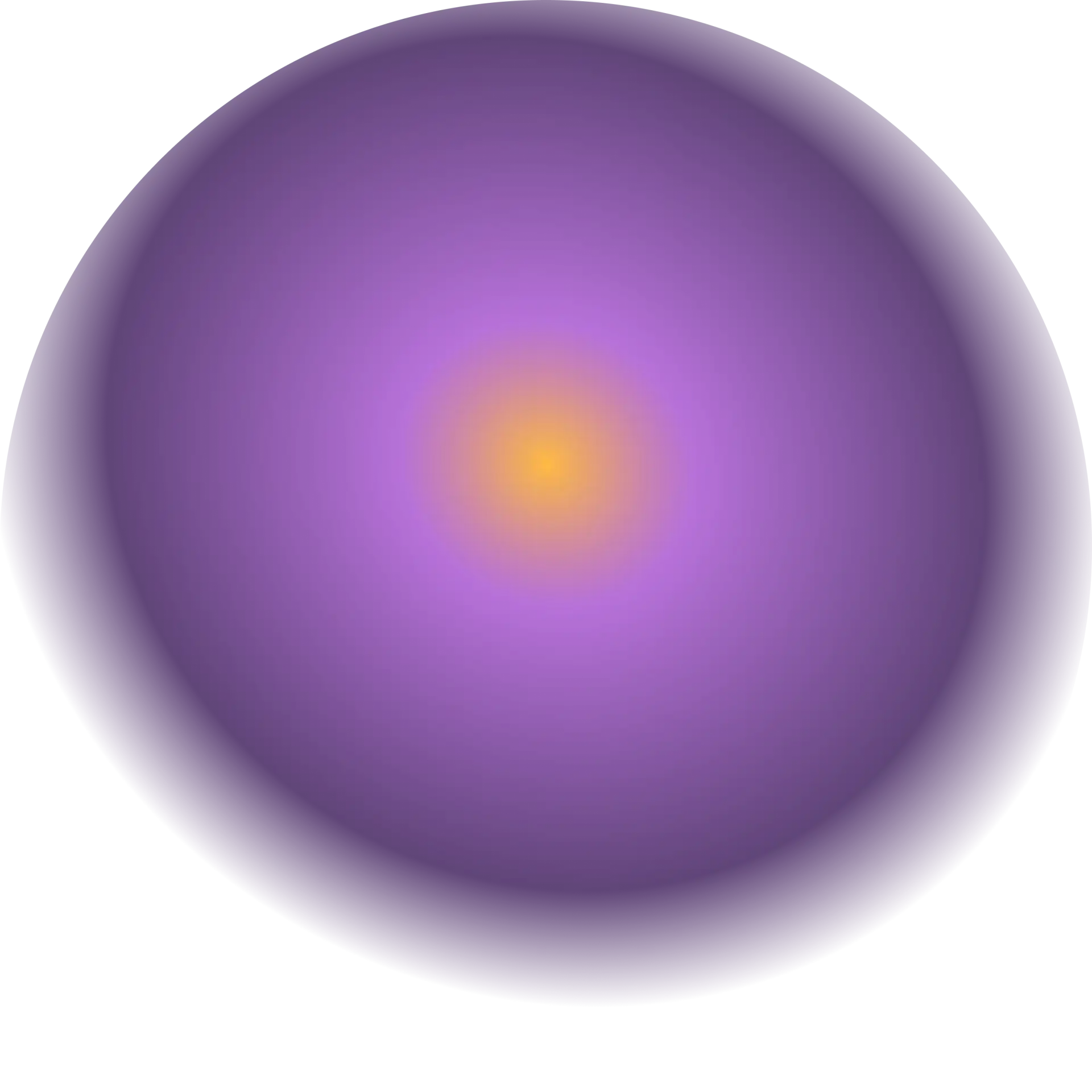
JavaScript UI Developer resume sample
- •Developed over 30 interactive UI components with React, enhancing user interactions and boosting web application speed by 20%.
- •Collaborated with UX teams and product managers to improve user satisfaction, which resulted in a 15% reduction in churn rate.
- •Implemented scalable front-end architectures to optimize application performance leading to a 25% decrease in server response time.
- •Led efforts in integrating new JavaScript frameworks, facilitating a 40% improvement in development efficiency.
- •Conducted code reviews and mentoring for junior developers, improving team productivity and product quality by 30%.
- •Spearheaded a project that delivered an engaging user interface, contributing directly to a 40% increase in user engagement.
- •Engineered versatile UI elements across mobile and web platforms using Vue.js, leading to a significant 35% performance efficiency.
- •Coordinated with graphic design teams to translate UX wireframes into visually appealing user interfaces.
- •Enhanced application speed by 20% by optimizing and refactoring legacy code.
- •Developed and implemented a set of best practices for UI development, resulting in a 50% improvement in project delivery timelines.
- •Managed version control using Git, leading to a seamless integration and deployment process that decreased errors by 25%.
- •Designed and developed a responsive web application with Angular, leading to a 50% increase in mobile user access.
- •Collaborated with back-end developers to integrate RESTful APIs, improving data retrieval efficiency by 40%.
- •Troubleshoot and debugged UI applications, reducing error rates by 30% through efficient resolution.
- •Managed cross-browser compatibility issues, ensuring a consistent user experience across various platforms.
- •Developed engaging web applications using JavaScript, increasing client satisfaction by 40%.
- •Optimized website performance, achieving a 20% reduction in loading times through efficient coding practices.
- •Worked alongside a vibrant team to implement responsive design principles resulting in a 50% rise in repeat visitors.
- •Enhanced functionality and design of existing systems by integrating new front-end technologies.
Front-End User Interface Developer resume sample
- •Designed and developed modular and optimized single-page applications using React, improving load times by 30%.
- •Led a team of 4 developers in a high-profile project, enhancing user engagement by 50% through seamless UI transitions.
- •Implemented comprehensive UI testing strategy resulting in a 20% reduction in user-reported bugs.
- •Collaborated with UX design team and implemented accessibility features, enhancing usability for disabled users by 70%.
- •Integrating RESTful APIs and third-party services, enhancing application functionality with live data and real-time updates.
- •Refactored legacy codebase, improved code clarity, and streamlined maintenance efforts leading to 25% faster development.
- •Revamped responsive design components, achieving consistent UI across devices and increasing mobile traffic by 40%.
- •Worked closely with cross-functional teams to implement new features, resulting in a 15% increase in user satisfaction.
- •Conducted performance optimization that led to a 35% enhancement in website speed and resolved complex CSS issues.
- •Streamlined version control processes by adopting Git, reducing deployment time and improving workflow collaboration.
- •Maintained continuous learning of front-end best practices and emerging technologies to ensure cutting-edge implementations.
- •Developed and maintained interactive web components, which increased user retention on new features by 25% within 3 months.
- •Optimized CSS and JavaScript execution across multiple web platforms, reducing lag time and improving browsing efficiency.
- •Collaborated with UX/UI designers to turn user insights into captivating interfaces, driving a 20% user interface improvement.
- •Identified and solved challenging bugs, achieving greater application stability and enhancing user experience.
- •Trained junior developers on front-end technologies, fostering skills development and promoting code quality.
- •Facilitated the design and deployment of a new site layout that increased daily active users by 15%.
- •Enhanced scalability of the web framework, resulting in 25% faster page loading times.
- •Effectively collaborated with the back-end team to integrate multiple APIs, enriching user interfaces with dynamic content.
- •Implemented analytics to study user behavior patterns, resulting in data-driven enhancements to the user interface.
Mobile UX/UI Developer resume sample
- •Led the redesign of a mobile payment app, enhancing user retention by 25% through strategic UI improvements.
- •Implemented a new design system for a health app, reducing user onboarding time by 15% through streamlined interface design.
- •Conducted usability testing on diverse demographics, identifying key UX issues leading to a 20% improvement in task success rates.
- •Collaborated with cross-functional teams to integrate user feedback, resulting in a 30% increase in customer satisfaction scores.
- •Championed the use of responsive design techniques for a global e-commerce app, improving accessibility across devices.
- •Stayed abreast of mobile trends, recommending innovations that enhanced the application’s visual appeal and interactivity.
- •Redesigned mobile sales app interfaces, boosting sales conversion rates by 40% through simplified user flows.
- •Developed a dynamic prototype for a lifestyle app that led to securing a $2 million investment from key stakeholders.
- •Optimized mobile interfaces for different screen sizes, resulting in a 50% reduction in user-reported display issues.
- •Conducted comprehensive user research across multiple countries, enhancing global user satisfaction by 18%.
- •Collaborated closely with developers to ensure design implementation fidelity, achieving 99% alignment with design specifications.
- •Developed interactive prototypes for educational apps, contributing to a 60% increase in user engagement.
- •Introduced new UX testing methods, which resulted in identifying and resolving over 75 usability pain points.
- •Refined mobile interfaces based on analytics data, improving the average session duration by 10%.
- •Presented UX design solutions at industry conferences, enhancing company reputation and attracting new clients.
- •Designed visually appealing interfaces for energy industry apps, increasing user acquisition by 20% in six months.
- •Collaborated with product managers to map user journeys, reducing feature navigation times by 25%.
- •Implemented feedback loops with users, significantly reducing complaints regarding the mobile app design.
- •Managed cross-departmental design workshops, fostering innovation and enhancing collaboration on various projects.
Senior User Interface Designer resume sample
- •Redesigned key product interfaces, significantly increasing user retention rates by 30% through enhanced usability and aesthetic appeal.
- •Led a team of designers to create a new style guide, achieving 100% brand consistency across multiple platforms and applications.
- •Conducted extensive user research and A/B testing, resulting in improved conversion rates by 25% across the company's digital platforms.
- •Mentored junior designers, directly contributing to a 40% reduction in onboarding time for design team newcomers.
- •Facilitated workshops for cross-functional teams to ideate and prototype, accelerating overall project delivery time by 20%.
- •Collaborated with developers and product managers, ensuring seamless and effective integration of design solutions into final products.
- •Improved the user interface of Adobe’s flagship application suite, resulting in a 15% increase in user satisfaction scores.
- •Developed wireframes and interactive prototypes for mobile apps, significantly reducing iteration cycles by 30%.
- •Implemented industry-standard design tools, increasing design efficiency by 20% through streamlined workflows and tool integrations.
- •Conducted usability testing and gathered insights, driving iterative improvements that led to a 10% reduction in error rates.
- •Collaborated with cross-functional global teams to ensure design standards and guidelines were uniformly adopted and adhered to.
- •Revamped UI for Microsoft's internal software tools, boosting employee productivity by 20% through streamlined navigation.
- •Partnered with UX researchers to analyze user feedback and improve interfaces, resulting in a 10% increase in task completion rates.
- •Assisted in mentoring junior designers, which led to a 50% improvement in design process understanding and skills.
- •Worked closely with developers to bridge the gap between design and implementation, ensuring fidelity to initial concepts.
- •Designed UI elements for Salesforce CRM, improving user engagement by 10% through intuitive navigation and layout enhancements.
- •Conducted competitive analysis to identify UI trends, resulting in the adoption of cutting-edge design techniques.
- •Utilized Sketch and Adobe Creative Suite to produce high-fidelity wireframes, ensuring early-stage feedback and alignment.
- •Collaborated with marketing teams to integrate brand messaging consistently across digital interfaces.
UI/UX Game Developer resume sample
- •Led design team in developing a user-friendly interface for a major game release, increasing user engagement by 35%.
- •Collaborated with developers and artists to integrate new interactive elements, reducing production bottlenecks by 20%.
- •Conducted in-depth user testing, resulting in a 30% improvement in initial user satisfaction ratings.
- •Streamlined design documentation and guidelines process, improving team efficiency by 25%.
- •Contributed to the adaptation of innovative design trends, leading to a 40% increase in positive feedback from game players.
- •Optimized cross-platform UI elements, reducing player confusion and error by 15%.
- •Designed and implemented user interfaces across mobile and console platforms, achieving a 20% increase in seamless user navigation.
- •Drove UI/UX improvements in collaboration with cross-functional teams, enhancing game overall quality by 25%.
- •Gathered and analyzed user feedback through usability tests, resulting in a 15% reduction in negative user experiences.
- •Standardized prototyping processes, allowing for a 10% faster delivery of game updates.
- •Mentored junior designers, improving their design and prototyping skills by 40% over a six-month period.
- •Contributed to the design of UI elements for a top-rated game, resulting in a 50% revenue growth.
- •Executed mockups and wireframes effectively, improving project approval turnaround time by 30%.
- •Collaborated with development team to optimize UI integration, reducing bug occurrences by 15%.
- •Participated in industry showcases, receiving accolades for design innovation.
- •Assisted in design phases of game development, contributing to a 20% faster launch time of games.
- •Implemented user-centered design principles that increased player retention rate by 10%.
- •Vetted new design tools, enhancing team productivity by 5%.
- •Engaged in cross-platform UI set-ups, minimizing discrepancies by 10% across devices.
Visual Interface Designer resume sample
- •Collaborated closely with UX designers and developers, leading to a 25% increase in cross-functional team efficiency.
- •Redesigned key components of the Adobe XD interface, resulting in a 30% improvement in user engagement.
- •Created and maintained the company's design system, ensuring branding consistency across 5 major product lines.
- •Developed high-fidelity mockups for mobile and desktop, enhancing user experience and leading to a 15% growth in customer satisfaction.
- •Conducted thorough visual quality assurance processes, reducing visual errors by 50% across digital products.
- •Facilitated design workshops which improved team creativity and generated 20 new interface concepts.
- •Designed intuitive user interfaces for the driver and rider apps that boosted user retention by 15%.
- •Collaborated with product teams to develop design solutions, significantly improving workflow efficiency by 20%.
- •Presented over 30 design concepts to key stakeholders, securing approval for 90% of proposed projects.
- •Integrated cutting-edge design trends into existing projects, improving visual appeal and user feedback scores.
- •Worked in agile environments, managing multiple project timelines simultaneously, enhancing project delivery rates by 25%.
- •Revamped Slack's visual hierarchy for the main interface, increasing user task completion rates by 20%.
- •Developed interface components that enhanced workflow, resulting in a 15% increase in user satisfaction.
- •Analyzed user feedback and testing data, translating insights into actionable design solutions.
- •Collaborated with teams to ensure design guidelines were consistently applied across different product areas.
- •Crafted visually appealing graphics for Pinterest's marketing campaigns, driving a 10% increase in user acquisition.
- •Ensured brand consistency across different media channels, resulting in a stronger brand image.
- •Developed engaging infographics, enhancing user interaction and knowledge retention.
- •Collaborated with marketing teams to produce digital assets that improved campaign effectiveness by 15%.
UI/UX Software Engineer resume sample
- •Led a team of 5 designers to overhaul the entire user interface of Adobe's flagship software, increasing user efficiency by 20%.
- •Conducted comprehensive user research resulting in a 30% improvement in stakeholder satisfaction ratings for product usability.
- •Developed a new design system that reduced development times by 25% and ensured branding consistency across platforms.
- •Facilitated cross-functional design workshops that fostered innovation and contributed to a 15% revenue increase.
- •Enhanced mobile application interfaces, achieving a 35% boost in user engagement through intuitive design practices.
- •Spearheaded the implementation of accessibility standards, resulting in a 40% wider user base including differently-abled users.
- •Collaborated on the redesign of Netflix's mobile app, leading to a 25% increase in daily active users.
- •Conducted user testing sessions that contributed to a 60% improvement in user satisfaction ratings.
- •Championed the integration of modern front-end frameworks, reducing load times by 15% and improving performance.
- •Worked closely with product managers to align design priorities with business goals, yielding a 10% increase in streaming time.
- •Mentored junior designers, facilitating growth and enhancing team productivity by 20%.
- •Implemented responsive web designs for Google Search, enhancing user interactions and reducing bounce rates by 18%.
- •Designed and prototyped new features for Google Maps resulting in a 22% increase in feature engagement.
- •Collaborated with backend engineers to streamline processes, cutting page load times by 30%.
- •Conducted competitive analyses and applied findings to improve design strategies, producing a 10% increase in usability scores.
- •Designed user-centric features for the iOS app store, boosting app downloads by 15% in the first year.
- •Worked with cross-functional teams to define design specifications and ensure consistency across Apple platforms.
- •Created high-fidelity prototypes that demonstrated a clear understanding of user needs, leading to a 20% reduction in feedback cycles.
- •Engaged in design sprints that accelerated product delivery and improved time to market by 25%.
Interaction Designer (UI/UX) resume sample
- •Led a team of designers to develop a complex SaaS product aimed at simplifying workflows, resulting in a 20% boost in client satisfaction scores.
- •Conceived and implemented a comprehensive design system, improving design consistency across platforms, reducing prototype timeframes by 40%.
- •Spearheaded user research initiatives, generating insightful data that informed design strategy and resulted in a 25% increase in usability ratings.
- •Collaborated closely with cross-functional teams, facilitating 10+ workshops to harmonize design objectives with product managers' vision.
- •Created high-fidelity prototypes in Figma, enabling a clearer user journey and reducing development errors by 15%.
- •Advocated for accessibility standards leading to implementation of WCAG 2.1 guidelines, enhancing the product experience for all users.
- •Redesigned mobile app interface, enhancing user satisfaction scores and increasing active user engagement by 25%.
- •Conducted extensive A/B testing and compiled reports that drove iterative design processes, increasing conversion rates by 15%.
- •Managed comprehensive wireframe and prototype projects using Sketch, which streamlined stakeholder presentations and decisions.
- •Facilitated user testing sessions that uncovered key insights, leading to improved accessibility features and a 30% increase in system usability.
- •Coordinated design sprints to align team priorities, resulting in project delivery ahead of schedule by 2 months.
- •Developed user-focused design strategies that enhanced product accessibility, contributing to a 30% year-over-year increase in user adoption.
- •Implemented HTML/CSS modifications based on user feedback, leading to a 20% reduction in reported product issues.
- •Organized regular design review meetings, fostering continuous feedback and resulting in improving product iteration timeline by 25%.
- •Leveraged Adobe Creative Suite to design visually compelling digital interfaces, strengthening brand uniformity across platforms.
- •Executed a comprehensive redesign for internal CRM, leading to a 40% improvement in employee productivity user feedback.
- •Incorporated responsive design practices that increased mobile platform usability ratings by 35%.
- •Devised and maintained user interface documentation, ensuring consistent application of design standards across all digital products.
- •Engaged with UX research teams, providing key design insights that shaped product enhancements and resulted in improved user retention.
Web User Interface Developer resume sample
- •Led a team of 4 developers to improve web interface speed by 30% through code optimization and advanced caching techniques.
- •Implemented responsive design solutions, resulting in a 40% increase in mobile and tablet user engagement within the first quarter.
- •Managed and ensured code quality with Git, reducing merge conflicts by 25% over six months by refining the workflow.
- •Integrated SEO best practices that improved search engine ranking by 15%, increasing site traffic and user retention.
- •Conducted user testing sessions that uncovered usability issues, providing actionable insights and leading to a 20% uplift in user satisfaction.
- •Collaborated with designers to bring complex wireframes to life, increasing project delivery speed by 20%.
- •Developed and maintained intuitive UI components using React, improving site usability and reducing the bounce rate by 12%.
- •Collaborated with a cross-functional team to refactor existing codebase, enhancing performance by 25% and reducing loading times.
- •Optimized images and resources, improving page load speed across the platform by 60% and enhancing user experience.
- •Conducted A/B testing, providing detailed analysis and feedback which increased feature adoption rate by 30%.
- •Implemented web accessibility standards, achieving a 98% compliance score and enhancing usability for all users.
- •Translated complex design specs into responsive interfaces using Vue.js, achieving a 35% increase in design accuracy.
- •Participated in cross-team workshops to enhance UI development processes, increasing efficiency by over 20%.
- •Reduced page load times by 15% through comprehensive performance analysis and implementing best practices.
- •Resolved critical bugs and interface issues in legacy projects, improving deployment success rate by 50%.
- •Built and launched user friendly interfaces, leading to a 22% increase in customer satisfaction ratings.
- •Worked closely with designers in continual improvement of interface designs reaching consistent cross-browser compatibility.
- •Enhanced site performance through image optimization, resulting in a 40% faster load time on key e-commerce pages.
- •Provided training and resources for team members, decreasing onboarding time by 30%.
UI Developer for VR/AR Technology resume sample
- •Led a team in redesigning the Oculus Home UI, increasing user satisfaction scores by 30%.
- •Implemented 3D UI elements using Three.js, improving user engagement metrics by 45% across key demographics.
- •Collaborated with cross-functional teams to develop features in Unity for the Oculus ecosystem, resulting in a 20% increase in user retention.
- •Optimized user interfaces to reduce loading times by 50%, enhancing overall user experience significantly.
- •Conducted usability testing sessions, resulting in a 40% reduction in navigation errors across the platform.
- •Documented UI specifications extensively, providing consistent guidelines that improved developer efficiency by 20%.
- •Designed and deployed intuitive interfaces for Magic Leap apps, raising user engagement by 30% quarter over quarter.
- •Implemented front-end systems with React, leading to faster development cycles and reduced maintenance time by 25%.
- •Enhanced accessibility features, resulting in a 15% increase in user base among accessibility-focused consumers.
- •Created high-fidelity prototypes for stakeholder review that cut down approval times by 40%.
- •Facilitated workshops on VR/AR best practices, improving team skill levels and project outcomes.
- •Developed Fortnite-themed UI components in Unreal Engine, leading to a 25% increase in user engagement.
- •Created modular front-end components with Vue.js, reducing redundancy and development time by 35%.
- •Troubleshot and optimized UI for cross-platform functionality, resulting in smoother gameplay experiences on all supported devices.
- •Collaborated with game designers to align UI/UX with gameplay mechanics, which enhanced the user interaction flow immensely.
- •Developed custom web applications using JavaScript and CSS, improving client satisfaction scores by 20%.
- •Conducted code reviews and mentored junior developers, enhancing the team's overall productivity by 15%.
- •Worked with client stakeholders to ensure projects met business objectives, resulting in successful project deliveries.
- •Implemented API integrations that streamlined data workflows and reduced overhead by 18%.
Crafting a standout resume as a user interface developer is like designing a friendly and intuitive interface for potential employers. Just like the interfaces you build, your resume should be both visually appealing and easy to navigate to show both creativity and technical skills. In a competitive tech world, where first impressions matter, perfecting your resume is vital for success.
One of the key challenges is effectively highlighting your skills and accomplishments. Showcasing your expertise in creating intuitive interfaces means your resume layout should also reflect this strength. Here, a well-crafted resume becomes your ally, metaphorically turning do’s and don’ts into a cohesive design that opens new opportunities.
Utilizing a resume template can help achieve this balance by organizing your content in a professional yet creative manner. These templates support you in maintaining a neat and concise presentation, emphasizing crucial sections without hindering your flair for creativity.
When it comes to detailing achievements and contributions, clarity is essential. While your projects demonstrate your abilities, your resume needs to explain your methods and the impact of your work clearly. Think of it as designing a wireframe, where every detail has a purpose and contributes to the overall picture.
With a well-crafted resume, you provide hiring managers with a clear view of your potential to enhance user experiences. It acts as your personal portfolio, offering insights into your skills and style. This ensures your resume not only reflects your professional identity but also sets the stage for future career growth.
Key Takeaways
- A user interface (UI) developer resume should effectively highlight your technical and design skills, ensuring the layout is visually appealing and easy to navigate.
- Utilizing a resume template can help maintain a professional yet creative presentation, allowing you to emphasize key sections without stifling creativity.
- Detailing your achievements and contributions with clarity, much like designing a wireframe, is essential to showing your work's impact and explaining your methods.
- Choose a reverse chronological resume format to emphasize recent experiences and ensure your resume is saved as a PDF to maintain consistent formatting across devices.
- The experience section should vividly convey your achievements using strong action verbs and quantifiable results to make your contributions stand out.
What to focus on when writing your user interface developer resume
As a user interface developer, your resume should clearly convey your expertise in creating intuitive and engaging digital experiences—this requires showcasing your proficiency in design tools and software engineering. Recruiters need a quick understanding of your strengths in designing and implementing user-friendly interfaces. Emphasizing your skills in both design principles and technical coding will illustrate your ability to create cohesive digital environments. Demonstrating your ability to merge aesthetic design with technical functionality is key to standing out.
How to structure your user interface developer resume
- Your Header must be professional and direct—include your name, phone number, email address, and a link to a LinkedIn profile or personal portfolio. This ensures recruiters have immediate access to your contact information and previous work samples. Including these links offers a deeper look into your work and makes you more approachable to potential employers.
- Your Professional Summary is where you make a powerful first impression—briefly outline your journey in user interface development, focusing on core tools like HTML, CSS, and JavaScript. Mention UX/UI design software that you've mastered. Tailor this section to highlight the unique experiences and skills that set you apart in the field.
- In the Skills section, communicate your technical prowess and design capabilities—list key abilities like responsive web design, wireframing, prototyping, and knowledge of design systems. By showcasing expertise in frameworks such as React or Angular, you demonstrate your adaptability and modern skill set in the evolving tech landscape.
- When detailing your Experience, focus on your contributions to past user interface projects—describe how you improved designs, implemented innovative solutions, and influenced project outcomes. Use action verbs to convey dynamism and include specific results to quantify your impact. This section highlights your practical application of skills and experience.
- The Education section should detail your formal training—highlight relevant degrees or certifications in design or computer science that underpin your qualifications. This establishes the foundation of your knowledge and commitment to continuous learning in the field.
- The Projects section allows you to further showcase your practical work—elaborate on specific user interface solutions you've implemented, detailing the technologies used and problem-solving strategies you employed. This gives a comprehensive view of your approach to challenges and creativity in execution.
Moving forward, understanding the right resume format is essential. Below, we’ll cover each section in more depth, ensuring your resume is thorough and compelling.
Which resume format to choose
A user interface developer resume should effectively spotlight your skills with a modern touch. By choosing the reverse chronological format, you emphasize your most recent experiences, showcasing your adaptability in the ever-evolving tech landscape. This approach allows recruiters to quickly grasp the progression of your career and your most relevant accomplishments.
Selecting the right fonts can enhance your resume's design. Modern options like Rubik, Montserrat, and Lato not only improve readability but also convey a contemporary feel. These fonts reflect current design sensibilities, which is essential in a field where aesthetics and user perception are key.
Preserving this polished look is best achieved by saving your resume as a PDF. This ensures your carefully designed layout remains consistent, regardless of the device or software used by hiring managers. It's a simple step that prevents potential formatting errors that could detract from your professionalism.
Furthermore, utilize one-inch margins on all sides to maintain a clean and organized appearance. Ample white space improves readability, making it easier for potential employers to focus on your qualifications. This neat presentation enhances your resume, leaving a lasting, positive impression on recruiters looking for clarity and attention to detail.
How to write a quantifiable resume experience section
Your experience section is essential for effectively showing your abilities and successes as a user interface developer. Start by tailoring your resume to align with each job application, ensuring everything matches the job description. Highlight your most recent and relevant roles from the past 10-15 years, focusing on positions that demonstrate your growth in the field. By structuring it in reverse chronological order, you ensure clarity, with your latest experiences appearing first. Use strong action verbs like "enhanced," "developed," or "implemented" to vividly convey your achievements, and emphasize quantifiable results that make your contributions stand out.
Here's how this approach looks in a strong experience section example:
- •Boosted website user engagement by 40% through innovative UI designs.
- •Directed a team of five to launch a mobile-first redesign, increasing traffic by 25%.
- •Reduced load times by 30% with advanced front-end technologies.
- •Worked with UX teams to improve client satisfaction scores by 15%.
This example excels by weaving clear language with strong evidence of your impact. The action words used not only grab attention but also seamlessly connect to the quantifiable results that follow. Starting with recent roles makes it easy for employers to follow your career path and quickly understand your relevance to user interface development. Each achievement is tied to the next, creating a cohesive narrative that highlights how your skills align with what employers seek. This approach ensures your experience leaves a memorable impression, setting you apart as a candidate.
Collaboration-Focused resume experience section
A collaboration-focused user interface developer resume experience section should emphasize how you’ve teamed up with others to achieve goals. Start by highlighting your teamwork, communication, and problem-solving skills, detailing roles where working together was key. Explain projects where you partnered with different departments, such as UX designers, project managers, or fellow developers, to drive success. This sets the stage for showing how collaboration can lead to tangible results.
In your bullet points, describe achievements that resulted from this teamwork, weaving in specific impacts like improved efficiency or enhanced user experience. Mention any tools or methods used, such as Agile or Scrum, that helped in these collaborative efforts. By demonstrating not only your ability to work well with others but also your dedication to reaching shared objectives, you effectively connect the dots for a potential employer.
User Interface Developer
Tech Innovators Inc.
May 2020 - March 2023
- Worked closely with a team of UX designers and developers to create an intuitive user interface for a SaaS platform, increasing customer satisfaction by 30%.
- Facilitated weekly cross-department meetings to ensure alignment on project goals, fostering a collaborative environment that improved efficiency by 20%.
- Implemented Agile methodologies to enhance team collaboration, leading to faster project delivery and improved communication among stakeholders.
- Joined a company-wide initiative to integrate feedback from customer service, resulting in user-centered design improvements.
Technology-Focused resume experience section
A technology-focused user interface developer resume experience section should clearly communicate your skills and achievements while maintaining a seamless flow. Begin by specifying the technology or platform you've worked with, like React or Angular, to set the context and draw the reader in. Next, use bullet points to detail your accomplishments and responsibilities, focusing on technical outcomes that highlight your strengths and demonstrate problem-solving abilities. For example, mention how interface improvements contributed to increased user satisfaction. Using action verbs can help keep your points engaging and concise, creating a dynamic overview of your contributions.
In the JSON example below, a structured format is provided to represent your experience, making it easy for employers to quickly grasp your accomplishments. This layout should include relevant details such as dates, titles, and specific tasks. This organization not only allows potential employers to see your value at a glance but also vividly portrays your expertise and dedication through concrete examples of your work.
UI Developer
Tech Innovations Inc.
January 2020 - March 2023
- Improved website responsiveness by 30%, leading to better user engagement.
- Led a team to redesign the company web platform, increasing user satisfaction by 25%.
- Integrated RESTful APIs to enhance data flow and system performance.
- Developed interactive user interfaces using React, resulting in a smoother user experience.
Training and Development Focused resume experience section
A training and development-focused user interface developer resume experience section should highlight your talent for teaching and mentorship alongside your technical skills. When describing your experience, use clear and concise language to reveal how you’ve empowered others with your UI development expertise. Mention the specific training techniques you employed, particularly those that enhanced team efficiency and deepened understanding of relevant tools and methodologies.
Ensure your claims are supported by tangible results, such as measurable improvements or glowing feedback that showcases your success in developing skills in others. If you’ve designed courses or led initiatives, explain how they contributed to team or project success. By detailing your experience in leading workshops, conducting training sessions, or serving as a mentor, you demonstrate your commitment to developing others. Employers should be able to quickly grasp the depth and impact of your work in these areas, understanding the value you bring to training and development.
Lead UI Developer
Innovative Tech Solutions
Jan 2020 - Present
- Designed and led monthly workshops for junior developers, covering UI best practices and emerging technologies.
- Mentored a team of 10+ developers, boosting productivity by 30% and reducing errors.
- Collaborated with cross-functional teams to tailor training materials, ensuring they were both relevant and engaging.
- Created a comprehensive online training module that received positive feedback from 95% of participants.
Customer-Focused resume experience section
A customer-focused user interface developer resume experience section should showcase your ability to enhance user experiences through collaboration and thoughtful design. Start by highlighting achievements that demonstrate your expertise in creating user-friendly interfaces, which seamlessly guide users and fulfill their needs. Illustrate how you’ve integrated user feedback into projects to improve designs, underscoring your commitment to customer satisfaction. Share success stories where your designs led to tangible improvements, such as increased user engagement or conversion rates, helping hiring managers appreciate the real-world impact of your contributions.
Connect each bullet point to specific accomplishments and the outcomes they produced. Incorporating numbers wherever possible adds clarity and impact, showing how your work made a difference. Demonstrate your ability to work well with teams or clients to emphasize your strong communication skills, essential in roles focused on meeting customer needs. Keep your language clear and straightforward to ensure your achievements are easily understood and keep the reader engaged.
User Interface Developer
Tech Solutions Inc.
June 2020 - Present
- Redesigned user interface, resulting in a 30% increase in user engagement.
- Collaborated with the product team to develop intuitive navigation, reducing customer queries by 20%.
- Conducted user testing sessions to gather feedback, leading to a 15% improvement in user satisfaction.
- Integrated accessibility features, enhancing the experience for users with disabilities.
Write your user interface developer resume summary section
A user interface developer-focused resume summary should succinctly encapsulate your skills, experience, and accomplishments to make your application stand out. This section acts as a snapshot of what you bring to the table. For those with experience, it's important to create a summary that highlights noteworthy successes and expertise. Blending your technical skills, like UX/UI design and coding knowledge, with soft skills such as collaboration and communication, paints a comprehensive picture of your capabilities. Here’s how you might do it:
This summary effectively communicates specific achievements and relevant skills by providing clear examples of your impact. It emphasizes your experience and quantifies your contributions while outlining key technologies. If you're just starting, a resume objective could be a better fit, detailing your goals and how you plan to contribute to a team. Here's an example:
[here was the JSON object 2]
This objective is crafted for newcomers by emphasizing enthusiasm and commitment while spotlighting key skills. The distinction between a resume summary and an objective lies in their focus; where a summary showcases past achievements, an objective outlines future goals. A resume profile typically merges these aspects, though it is less commonly used. Meanwhile, a summary of qualifications lists key skills and accomplishments in bullet points, often suitable for roles demanding fine detail. Choosing between a summary, objective, profile, or qualifications depends largely on your experience and the job you’re targeting. Whatever the choice, tailoring this section to the job description enhances your application’s appeal.
Listing your user interface developer skills on your resume
A skills-focused user interface (UI) developer resume should highlight the abilities that make you stand out in the tech world. You can choose to feature your skills as a standalone section or weave them creatively into your experience and summary. Your resume benefits most when hard skills—such as coding in programming languages or mastering design software—are clearly outlined. At the same time, your strengths and soft skills emphasize your personal qualities like effective communication and problem-solving, making your profile more well-rounded.
These skills and strengths aren't just a list; they serve as important keywords. They can grab the attention of recruiters and navigate smoothly through applicant tracking systems (ATS). Selecting the right keywords helps your resume get noticed in those crucial first screenings.
Here's an example of a solid standalone skills section in JSON format for a UI Developer:
This section is effective because it highlights relevant skills that align with the common demands of UI development. It's straightforward and speaks directly to what employers are looking for.
Best hard skills to feature on your user interface developer resume
Emphasizing the right hard skills shows potential employers your technical prowess. These abilities communicate your capacity to create visually appealing and highly functional interfaces.
Hard Skills
- JavaScript
- HTML/CSS
- React.js
- Angular
- User Interface (UI) Design
- User Experience (UX) Design
- Responsive Web Design
- Wireframing
- Prototyping
- Version Control/Git
- Cross-browser Compatibility
- Sketch
- Adobe XD
- Visual Studio Code
- Sass/Less
Best soft skills to feature on your user interface developer resume
In addition to technical skills, showcasing strong soft skills indicates how well you can collaborate and solve problems within a team. Attributes like these show your ability to thrive in dynamic settings and adapt to new challenges.
Soft Skills
- Communication
- Problem-solving
- Time management
- Team collaboration
- Adaptability
- Attention to detail
- Creativity
- Critical thinking
- Emotional intelligence
- Patience
- Networking
- Empathy
- Initiative
- Resilience
- Open-mindedness
How to include your education on your resume
The education section is an essential part of your resume as a user interface developer. This section shows potential employers the skills and knowledge you have acquired through formal studies. It's important to tailor this section to the position you're applying for, meaning you should only include relevant education. Avoid listing degrees or training that don't relate to user interface development.
Including your GPA is optional, but if it's impressive, you can showcase it. Add it alongside your degree in the format "GPA: 3.8/4.0". If you graduated with honors like cum laude, it’s a great way to highlight your academic achievements. You can list it right after your degree title. When listing a degree, always start with the degree itself, followed by the institution, location, and the dates of attendance.
The right example stands out because it includes a relevant degree in Computer Science, aligns with the role of user interface development, and showcases a strong GPA with honors. Highlighting specific achievements like graduating magna cum laude can make you more appealing to recruiters. The dates listed help demonstrate your educational timeline, reflecting a solid foundation in the field. This tailored approach shows you're focused and suited for a user interface developer position.
How to include user interface developer certificates on your resume
Including a certificates section in your resume is crucial for showcasing your skills and expertise as a user interface developer. Begin by listing the name of the certificate clearly, followed by including the date you earned it. It's also important to add the issuing organization to provide credibility. Displaying certificates can also be effective if you include them in the header of your resume. For example, right below your name, you could add "Certified User Interface Developer – Adobe Certified Associate."
Highlighting certifications relevant to your role strengthens your resume. Certificates show you are dedicated to learning and improving your skills. Below is an example of a well-structured certificates section that a user interface developer could use. The classification of the certificates underlines your qualifications and commitment to the industry.
The example is good because it includes well-recognized certifications in the field like Adobe Certified Expert, which is highly relevant for UI developers. It also highlights a modern course on UX design from Coursera, showing that you keep up with current industry trends. Providing these details makes your resume stand out and positions you as a knowledgeable specialist.
Extra sections to include on your user interface developer resume
A user interface developer plays a crucial role in shaping the visual and interactive elements of digital products. Crafting a resume that highlights your skills and experiences while also showcasing your personality can set you apart in this competitive field.
Highlighting your language skills can show your ability to collaborate effectively in multilingual teams. Language section — List the languages you speak or write to show your ability to communicate across diverse teams or work with global platforms.
Sharing your personal passions can make your resume more relatable. Hobbies and interests section — Mention interests that align with your work to reflect your creative and analytical skills, such as photography or coding small projects.
Showcasing your volunteer work can enhance your personal brand as someone who values community engagement. Volunteer work section — Include volunteer experience to demonstrate your commitment to giving back and your ability to work well with diverse groups.
Revealing the books you're engaged with can offer insights into your continuous learning and professional development. Books section — List influential books you read that relate to user interface or technical skills, which can illustrate a proactive approach to growth and knowledge.
By thoughtfully including these sections, you enhance your resume with depth and authenticity that employers value.
In Conclusion
In conclusion, crafting a standout resume as a user interface developer requires a balance of demonstrating your technical expertise and showcasing your personal flair. Your resume should serve as a functional design interface, guiding potential employers through your qualifications and achievements effectively. By selecting the right resume format and using clear, engaging language, you ensure your professional journey is communicated in a compelling way. Highlighting both hard and soft skills provides a holistic view of your abilities, making you a more attractive candidate in a competitive market. Your education and certifications showcase your dedication and readiness to tackle any challenge. Additional sections, like personal projects or volunteer experiences, can add unique dimensions to your profile, offering a fuller picture of who you are. Remember, your resume is your personal brand ambassador on paper, inviting hiring managers to learn more about you. Make sure it tells a cohesive story that aligns with your career goals. Focusing on clarity, precision, and relevance will boost your chances of making a strong impression, bringing you closer to your next opportunity.
Related Articles
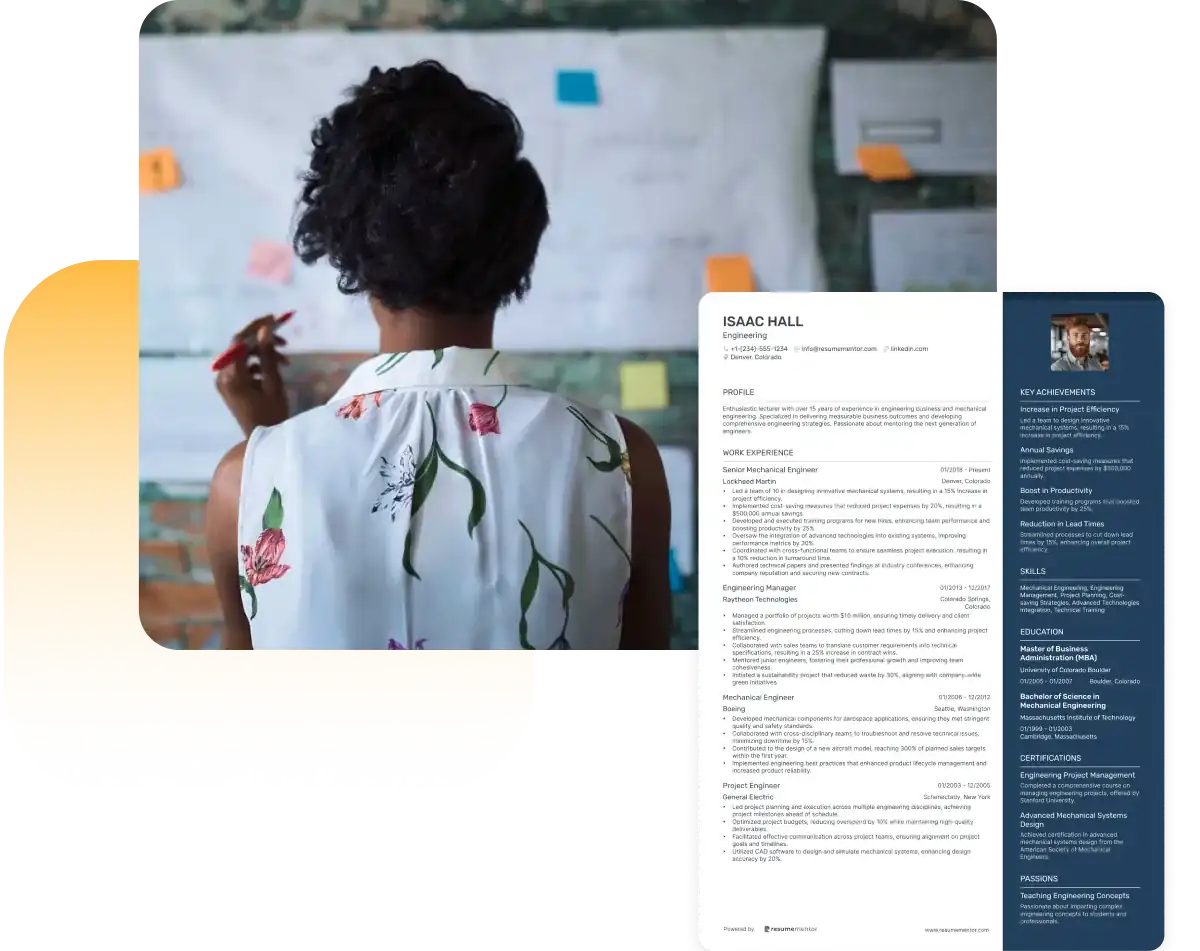
Continue Reading
Check more recommended readings to get the job of your dreams.
Resume
Resources
Tools
© 2026. All rights reserved.
Made with love by people who care.

